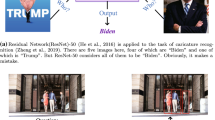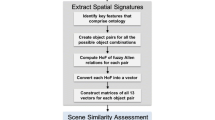Abstract
A representation scheme of knowledge at both the geometric and conceptual levels is offered which extends a generative theory of visual perception. According to this theory, the perception process proceeds through different scene representations at various levels of abstraction. The geometric domain is modeled following the CSG (constructive solid geometry) approach, taking advantage of the geometric modelling scheme proposed by A. Pentland, based on superquadrics as representation primitives. Recursive Boolean combinations and deformations are considered in order to enlarge the scope of the representation scheme and to allow for the construction of real-world scenes. In the conceptual domain, objects and relationships are represented using KL-ONE, a frame-based knowledge representation formalism which allows hierarchical and structural descriptions. Questions arising from the integration of logical and analogical knowledge representation are also faced; in the end likeness and approximation relationships between objects and prototypical conceptual models for classification purposes are investigated within the framework of fuzzy set theory.
Similar content being viewed by others
Explore related subjects
Discover the latest articles, news and stories from top researchers in related subjects.References
Marr, D. and Nishihara, K., Representation and recognition of the spatial organizaton of threedimensional shapes, Proc. Roy. Soc. London B, 200, 269–294 (1978).
Pentland, A.P., Perceptual organization and the representation of natural form, Artificial Intelligence 28, 293–331 (1986).
Gaglio, S. Spinelli, G. and Tagliasco, V., Visual perception: an outline of a generative theory of information flow organization, Theoretical Linguistics 11, 21–43 (1984).
Wertheimer, M., Laws of organization in perceptual forms, in W.D.Ellis (ed.), A Source Book of Gestalt Psychology, Harcourt Brace, New York (1923).
Requicha, A.A. and Voelcker, H.B., Solid modeling: a historical summary and contemporary assessment, IEEE Computer Graphics and Applications, March 1982, pp. 9–24.
Tilove, R.B., Set membership classification: a unified approach to geometric intersection problem, IEEE Trans. Computers C29, 874–883 (1980).
Barr, A.H., Superquadrics and angle-preserving transformations, IEEE Computer Graphics and Applications, Jan. 1981, pp. 11–23.
Franklin, W.R. and Barr, A.H., faster calculation of superquadric shapes, IEEE Computer Graphics and Applications, July 1981, pp. 41–46.
Solina, F. and Bajcsy, R., Shape and function, SPIE 726 Intelligent Robots and Computer Vision: Fifth in a Series (1986) pp. 284–291.
Bajcsy, R. and Solina, F., Three dimensional object representation revisited, Proc. 1st Intern. Conf. on Computer Vision, England, June 8–11, 1987, pp. 231–240.
Pentland, A.P., Fractal-based description of natural scenes, IEEE Trans. Pattern Anal. Machine gence 6, 661–674 (1984).
Mandelbrot, B.B., The Fractal Geometry of Nature, Freeman, San Francisco (1982).
Putnam, L.K. and Subrahmanyam, P.A., Boolean operations on n-dimensional objects, IEEE Computer Graphics and Applications, June 1986, pp. 43–51.
Faux, U.D. and Pratt, M.J., Computational Geometry for Design and Manufacture, Ellis Horwood, Chichester (1985).
Pentland, A., Recognition by parts, SRI Technical Note No. 406, Menlo Park, CA (1986).
Ardizzone, E., Palazzo, M.A. and Sorbello, F., Computer Reconstruction and Description of 3-D objects, Proc. IASTED Int. Symp. on Simulations and Modeling, Lugano, Switzerland, June 19–22, 1989.
Chien, C.H. and Aggarwal, J.K., A volume/surface octres representation, Proc. 7th Int. Conf. Pattern Recognit., Montreal, Canada, July 30–August 2, 1984, pp. 817–820.
Chien, C.H. and Aggarwal, J.K., Identification of three-dimensional objects from multiple silhouettes using Quadtrees/Octrees, Computer Vision, Graphics, and Image Processing 36, 256–273 (1986).
Noborio, H., Fukuda, S. and Arimoto, S., Construction of the Octree approximating three-dimensional objects by using multiple views, IEEE Trans. Pattern Anal. Machine Intelligence 10, 769–782 (1988).
Likins, P. W., Elements of Engineering Mechanics, McGraw-Hill, New York (1973).
Brachman, R.J. and Schmolze, J.G., An overview of the KL-ONE knowledge representation system, Cognitive Science 9, 171–216 (1985).
Minsky, M., A framework for representing knowledge, in P.Winston (ed.); The Psychology of Computer Vision, McGraw-Hill, New York (1975).
Gaglio, S., Minciardi, R. and Puliafito, P. P., Multiperson decision aspects in the construction of expert systems, IEEE Trans. Systems, Man and Cybernetics, SMC15, 536–539 (1985).
Brachman, R.J., ‘I Lied about the trees’ - or, defaults and definitions in knowledge representation, The Al Magazine, Fall 1985, pp. 80–93.
Zadeh, L.A., The concept of a linguistic variable and its application to approximate reasoning-I, Inform. Sci. 8, 199–245 (1975).
Zadeh, L.A., The concept of a linguistic variable and its application to approximate reasoning-II, Inform. Sci. 8, 301–357 (1975).
Zadeh, L.A., The concept of a linguistic variable and its application to approximate reasoning-III, Inform. Sci. 9, 43–80.
Zadeh, L.A., Fuzzy logic, IEEE Comp., April 1988, 83–93.
Hayes-Roth, B., A blackboard architechture for control, Artificial Intelligence 26, 251–321 (1988).
Author information
Authors and Affiliations
Rights and permissions
About this article
Cite this article
Ardizzone, E., Gaglio, S. & Sorbello, F. Geometric and conceptual knowledge representation within a generative model of visual perception. J Intell Robot Syst 2, 381–409 (1989). https://doi.org/10.1007/BF00247915
Received:
Accepted:
Issue Date:
DOI: https://doi.org/10.1007/BF00247915




